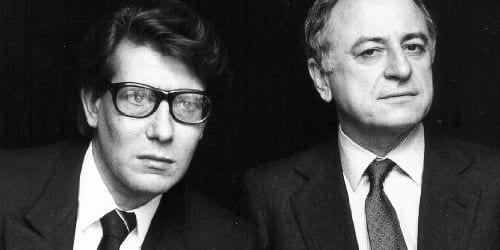
Throughout a career that spanned more than five decades, Yves Saint Laurent became a beacon of style, class and elegance. Upon his death in 2008, people the world over got more profound insight into his private life, when his partner and colleague Pierre Bergé decided to auction the entire art collection they’d amassed together.
Considered one of the most impressive private collections in history, the designer’s various homes ( he owned properties in France and Marrakesh) were decorated with pieces by Picasso, Cezanne, Giacometti, Gericault, Duchamp and many others. Originally set to chronicle this historical auction, Pierre Thoretton’s documentary L’amour fou instead becomes a melancholy piece that examines the life and times of a man who changed the way people think of clothes.
Alternating between a chronology of Saint Laurent’s life and the organization of the auction, the film covers enough subjects to appeal to fashion lovers, as much as casual viewers interested in good old fashioned cinematic spectacle. Layered with humanity and sincere interest in the story it’s telling, the film steers clear from falling into “poor rich people” stereotypes and even seems to avoid any sort of sexual or political agenda (that Bergé and Saint Laurent were two men in love is never turned into an “issue”).
What we see instead is a portrait of endurance, perseverance and chance to some degree. We learn that Pierre and Yves did not originally meet in some glamorous gala or star studded benefit, but instead at Pierre Cardin’s funeral. Yves had been the iconic designer’s apprentice and would eventually inherit the legendary couture house, becoming — at 21 years old — one of the youngest grand couturiers in history.
When the time came for him to move on to greener pastures, he and Berge decided that it just wouldn’t do to work for another of the big fashion houses. Instead, the two set out to create the YSL empire. Listening to Bergé’s account is altogether more fascinating because it mixes emotion with pure capitalism. For every heartfelt mention of how much he loved Yves and how he knew they would be together forever shortly after meeting him, there is a pervasive, somewhat dark acknowledging that sometimes pleasure and business can go hand in hand.
We listen to Bergé’s recollections and wonder if this is who he is or if he’s keeping a few secrets from the camera. We notice that the filmmaker has the same doubt, as he tries to catch Pierre revealing more than he wants without much success. The closer he gets is through distant glances, especially when Pierre talks about the art pieces in the collection. It never becomes entirely clear to us why he would want to get rid of everything, instead of holding on to them like mementos of the man he loved.
Through archival interviews we get a sense that despite his shyness and introspection, Yves had something that resembled a tragic self-awareness. Behind his iconic eyeglasses and sweet smile was a man who never really tried to absolve his public persona of the accusations of extreme hedonism thrown at him by the media. We see him partying in Studio 54 and learn that not only was this done purposely for public attention, it also went against who he was inside.
Yves, it turns out, was a being plagued by endless contradictions. He loved the idea of travel and exotic lands but instead of visiting them, he preferred to recreate them in tiny, controllable, spaces (we see how inspired by Chekhov he created a Zhivago-esque palace in one of his houses). The camera explores these spaces using long pans that fail to absorb the entire richness of its surroundings. There is just way too much to see (as is proven by almost an hour of bonus footage, which sadly isn’t organized well enough for viewers to enjoy fully) and this optical inefficiency is actually able to encompass the film thematically.
With so many paradoxes going on, we begin to wonder what the film is truly about. Even if it never feels aimless, rarely does it seem to be making a specific point and at times its elusiveness seems to make us think this is one clotheless emperor.
However, it achieves some sort of poignancy by making us reexamine the value we give to objects and their roles in our lives. This is curious, considering that Yves Saint Laurent’s own line of work is usually the object of discussions about its artistic worth. Since the film examines this without the emotional filter Olivier Assayas used in his moving Summer Hours (which covers similar themes) we are left with a harsher look at life: one where whether we’re famous or not, we are warned that we might become nothing but ghosts who haunt the lives of those who once knew and loved us.

![Call for Papers: All Things Reconsidered [MUSIC] May-August 2024](https://www.popmatters.com/wp-content/uploads/2024/04/all-things-reconsidered-call-music-may-2024-720x380.jpg)



